1. Introduction
If oxygen is present in a cell where respiration is occurring, then glycolysis (1) is followed by the Link Reaction (2) and the Krebs Cycle (3). Together, these reactions completely oxidize pyruvate (pyruvic acid) and the molecules it gets broken down into.
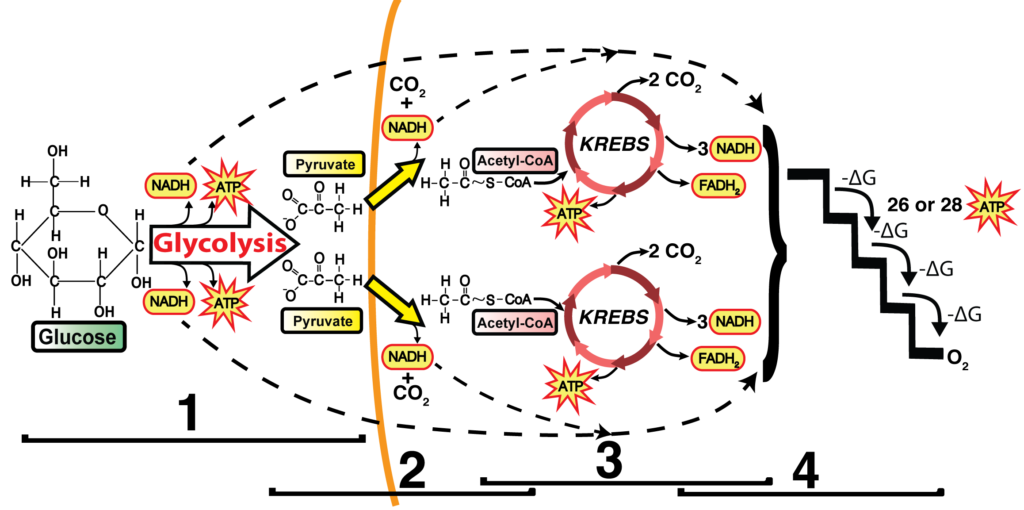
These oxidations are coupled to the generation of the reduced, energy-rich, mobile electron carriers NADH and FADH2. In the electron transport chain (step 4) these electron carriers will power the creation of about 7/8 of the ATP generated by aerobic cellular respiration. The other 1/8 is generated by the substrate-level phosphorylations that occur during glycolysis and the Krebs cycle.
2. The Link Reaction
The starting compound in the link reaction is pyruvic acid, or pyruvate, the molecule that comes out of glycolysis.
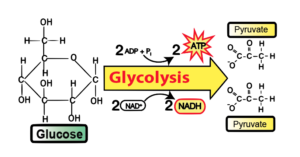
As shown above, two pyruvates are generated for each glucose that enters glycolysis. Though glucose was oxidized during glycolysis, with enzymes using its chemical bond energy to generate two NADHs and two ATPs, pyruvic acid still has energy that the cell can harvest.
That harvest begins in the link reaction, which can be organized into three steps:
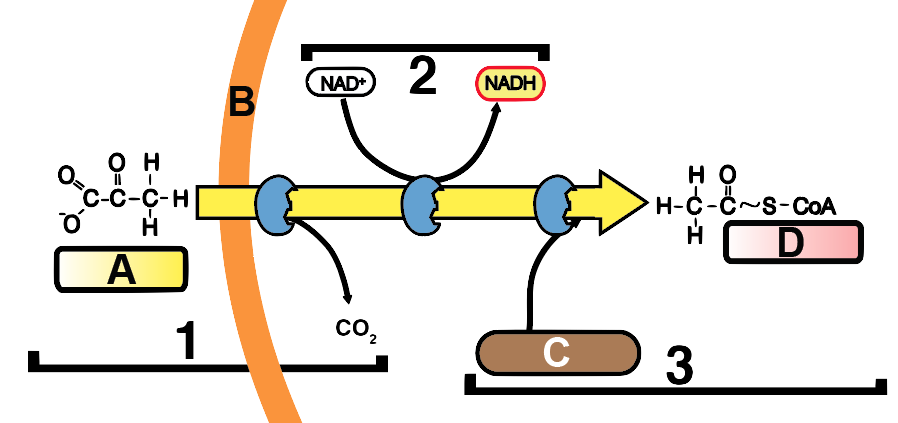
- The link reaction begins with pyruvic acid (letter “A”) diffusing into the mitochondrial matrix through the mitochondrial membrane (“B”). As pyruvate enters, enzymes snip off its carboxyl group (which you can see on the left side of the structural formula of pyruvate). Snipping off the carboxyl group releases a molecule of carbon dioxide (CO2), which accounts for one-third of the CO2 generated in cellular respiration. Think about that the next time you exhale.
- In the second step, enzymes take what’s left of pyruvate and oxidize it. The energetic electrons harvested in this oxidation flow to the mobile electron carrier NAD+, reducing it to NADH.
- That leaves a two-carbon acetyl group (C2H3O). Enzymes attach this acetyl group to Coenzyme A, which acts as a kind of shuttle, delivering the acetyl group to the Krebs cycle. Coenzyme A is shown at “C,” and the combination of an acetyl group and Coenzyme A is called acetyl CoA (shown at “D”).
The chemical bonds in the acetyl group are full of potential energy. During the Krebs cycle, those bonds will power the formation of ATP, NADH, and FADH2. But first, let’s make sure we understand the link reaction.
[qwiz random = “true” qrecord_id=”sciencemusicvideosMeister1961-Link Reaction (2.0)”]
[h]The Link Reaction
[i]
[q labels = “top”]
[l]Acetyl-CoA
[fx] No, that’s not correct. Please try again.
[f*] Good!
[l]Coenzyme A
[fx] No, that’s not correct. Please try again.
[f*] Good!
[l]CO2
[fx] No. Please try again.
[f*] Excellent!
[l]NADH
[fx] No, that’s not correct. Please try again.
[f*] Correct!
[l]NAD+
[fx] No. Please try again.
[f*] Great!
[l]Pyruvate
[fx] No. Please try again.
[f*] Excellent!
[l]cytoplasm
[fx] No, that’s not correct. Please try again.
[f*] Good!
[l]mitochondrial matrix
[fx] No, that’s not correct. Please try again.
[f*] Correct!
[q]Which letter or number refers to pyruvic acid?
[textentry single_char=”true”]
[c]IE E=[Qq]
[f]IFllcywg4oCcQeKAnSBpcyB0aGUgcHlydXZpYyBhY2lkLg==[Qq]
[c]Kg==[Qq]
[f]Tm8uIEhlcmUmIzgyMTc7cyBhIGhpbnQuIFB5cnV2aWMgYWNpZCAob3IgcHlydXZhdGUpIGlzIHRoZSB0aHJlZS1jYXJib24gbW9sZWN1bGUgdGhhdCBlbmRzIGdseWNvbHlzaXMgYW5kIGJlZ2lucyB0aGUgbGluayByZWFjdGlvbi4=
Cg==[Qq]
[q]Which letter or number refers to the mitochondrial membrane?
[textentry single_char=”true”]
[c]wq BC[Qq]
[f]IFllcywg4oCcQuKAnSBpcyB0aGXCoG1pdG9jaG9uZHJpYWwgbWVtYnJhbmUu[Qq]
[c]Kg==[Qq]
[f]Tm8uIFdoYXQmIzgyMTc7cyB0aGUgb25seSB0aGluZyBpbiB0aGlzIGRpYWdyYW0gdGhhdCByZW1vdGVseSBsb29rcyBsaWtlIGl0IGNvdWxkIGJlIGEgbWVtYnJhbmU/
Cg==[Qq]
[q]Which letter or number refers to co-Enzyme A?
[textentry single_char=”true”]
[c]wq BD[Qq]
[f]IFllcywg4oCcQ+KAnSBpcyBjby1Fbnp5bWUgQS4=[Qq]
[c]Kg==[Qq]
[f]Tm8uIEhlcmUmIzgyMTc7cyBhIGhpbnQuIENvLWVuenltZSBBIGVudGVycyB0aGUgbGluayByZWFjdGlvbiBhbmQgYmluZHMgd2l0aCB0aGUgdHdvLWNhcmJvbiBtb2xlY3VsZSB0aGF0JiM4MjE3O3MgbGVmdCBhZnRlciBweXJ1dmF0ZSBoYXMgaGFkIGEgQ08=Mg==wqByZW1vdmVkIGZyb20gaXQgYW5kIGhhc8KgYmVlbiBveGlkaXplZCAoaW4gc3RlcHMgMSBhbmQgMikuIFdoYXQgZG8geW91IHNlZSBjb21pbmcgaW50byB0aGUgbGluayByZWFjdGlvbiB0byBiaW5kIHdpdGggdGhlIHR3byBjYXJib24gbW9sZWN1bGUgdGhhdCByZW1haW5zPw==
Cg==[Qq]
[q]Which letter or number refers to Acetyl CoA?
[textentry single_char=”true”]
[c]wq BE[Qq]
[f]IFllcywg4oCcROKAnSBpcyBBY2V0eWwgQ29BLg==[Qq]
[c]Kg==[Qq]
[f]Tm8uIEhlcmUmIzgyMTc7cyBhIGhpbnQuIEFjZXR5bCBDb0EgaXMgYSB0d28tY2FyYm9uIG1vbGVjdWxlLCBhdHRhY2hlZCB0byBDb2VuenltZSBBLg==
Cg==[Qq]
[q]Which letter or number refers to the step where molecules from food are oxidized?
[textentry single_char=”true”]
[c]wq Ay[Qq]
[f]IFllcywg4oCcMuKAnSBpbnZvbHZlcyB0aGUgb3hpZGF0aW9uIG9mIG1vbGVjdWxlcyBkZXJpdmVkIGZyb20gZm9vZCAoc3VjaCBhcyBnbHVjb3NlKS4gVGhhdCBveGlkYXRpb24gaXMgcG93ZXJpbmcgdGhlIHJlZHVjdGlvbiBvZiBOQUQ=Kw==IHRvIE5BREgu[Qq]
[c]Kg==[Qq]
[f]Tm8uIEhlcmUmIzgyMTc7cyBhIGhpbnQuwqBPeGlkYXRpb25zIGFyZSBwYWlyZWQgd2l0aCByZWR1Y3Rpb25zLCBhbmQgdGhlIHJlZHVjZWQgcHJvZHVjdCBvZiB0aGUgbGluayByZWFjdGlvbiBpcyBOQURILg==
Cg==[Qq]
[q]Which number refers to the step where Acetyl CoA gets produced?
[textentry single_char=”true”]
[c]wq Az[Qq]
[f]IFllcy4gSW4gc3RlcCDigJwzLOKAnSBhIHR3by1jYXJib24gYWNldHlsIGdyb3VwIGlzIGF0dGFjaGVkIHRvIENvZW56eW1lIEEsIHJlc3VsdGluZyBpbiBhY2V0eWwgQ29BLg==[Qq]
[c]Kg==[Qq]
[f]Tm8uIEhlcmUmIzgyMTc7cyBhIGhpbnQuIExvb2sgZm9yIGEgdHdvLWNhcmJvbiBhY2V0eWwgZ3JvdXAsIGF0dGFjaGVkIHRvIENvRW56eW1lIEEgKGxvb2sgZm9yIH5TLUNvQSkuIFdoZXJlIGlzIHRoaXMgYmVpbmcgZm9ybWVkPw==
Cg==[Qq]
[q]In which step are enzymes snipping a carboxyl group off of pyruvic acid?
[textentry single_char=”true”]
[c]wq Ax[Qq]
[f]IFllcy4gSW4gc3RlcCDigJwxLOKAncKgZW56eW1lcyBhcmUgcmVtb3ZpbmcgYSBjYXJib3h5bCBncm91cCBmcm9tIHB5cnV2aWMgYWNpZC4=[Qq]
[c]Kg==[Qq]
[f]Tm8uIEhlcmUmIzgyMTc7cyBhIGhpbnQuIFdoZW4gdGhhdCBjYXJib3h5bCBncm91cCBnZXRzIHJlbW92ZWQsIENPMg==IGdldHMgcmVsZWFzZWQuIFdoaWNoIHN0ZXAgcmVsZWFzZXMgQ08=Mg==Pw==
[Qq][q]In which step is a reduced electron carrier being generated?
[textentry single_char=”true”]
[c]wq Ay[Qq]
[f]IFllcy4gSW4gc3RlcCDigJwy4oCdIE5BREgsIGEgcmVkdWNlZCBlbGVjdHJvbiBjYXJyaWVyLCBpcyBiZWluZyBnZW5lcmF0ZWQu[Qq]
[c]Kg==[Qq]
[f]Tm8uIEhlcmUmIzgyMTc7cyBhIGhpbnQuIFRoZSBlbGVjdHJvbiBjYXJyaWVycyBpbnZvbHZlZCBpbiBjZWxsdWxhciByZXNwaXJhdGlvbiBhcmUgTkFESCBhbmQgRkFESA==Mg==LiBXaGVyZSBkbyB5b3Ugc2VlIGVpdGhlciBvZiB0aGVzZSBtb2xlY3VsZXMgYmVpbmcgZ2VuZXJhdGVkPw==[Qq]
[/qwiz]
3. The Krebs Cycle
3a. Some Details
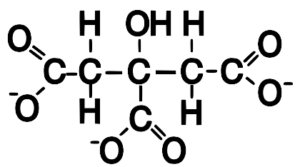
The Krebs cycle lies at the center of aerobic (oxygen-using) metabolism. The cycle goes by three names.
- Krebs Cycle is for Hans Krebs (1900 – 1981) the scientist who worked out the cycle in the 1930s. Krebs won the Nobel prize for this work in 1953.
- Citric Acid Cycle is for the six-carbon compound (Citric Acid, or citrate) that forms at the start of the cycle. If you haven’t already, take a look at the structural formula for citric acid to your left.
- TCA cycle: TCA is an acronym for tri-carboxylic acid, another name for Citric Acid. Look at the structural formula for Citric Acid and find the three carboxyl groups.
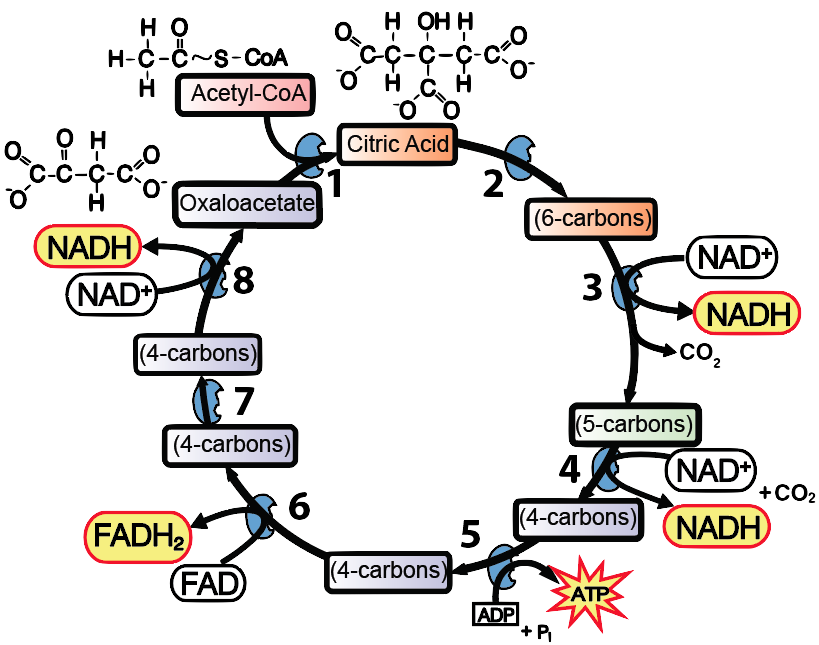 To emphasize the key points about the Krebs Cycle, I’ve created the diagram to your left. Note that it includes only three named compounds (which I’ll say more about below). For all of the other primary substrates for the enzymatic reactions that make up the cycle, I’ve listed only the number of carbons that make up the compound. That’s because that’s more than enough detail for AP Biology.
To emphasize the key points about the Krebs Cycle, I’ve created the diagram to your left. Note that it includes only three named compounds (which I’ll say more about below). For all of the other primary substrates for the enzymatic reactions that make up the cycle, I’ve listed only the number of carbons that make up the compound. That’s because that’s more than enough detail for AP Biology.
Here are the key things to know. Refer to the diagram as you read.
- Acetyl CoA brings chemical energy into the cycle in the form of a two-carbon acetyl group. Those two carbons, with their attached hydrogen atoms, were at one point a part of glucose (or another food molecule).
- At the start of the Krebs cycle, enzymes detach the two-carbon acetyl group from Acetyl CoA and attach it to a four-carbon molecule called oxaloacetate (also known as oxalic acid). This is reaction “1” in the diagram above. The result is the six-carbon molecule Citric Acid.
- The rest of the cycle involves enzymes that do one or more of the following:
- molecular rearrangements that change citric acid or its derivatives into other forms that become the substrates for the next reaction. Reactions “2” and “7” are rearrangements.
- removing carboxyl groups, resulting in the release of carbon dioxide. You can see the removal of CO2 at “3” and “4.” Note that when this occurs, the molecules in the cycle are losing carbon atoms (and hence, 6-carbon molecules become 5-carbon molecules, and 5-carbon molecules become 4-carbon molecules)
- Oxidation-Reduction Reactions. The food-derived molecules in the cycle are oxidized. These oxidations power the reduction of the electron carriers NAD+ to NADH and FAD to FADH2. Oxidation-reductions occur in reactions “3,” “4,” “6,” and “8.”
- Substrate-level phosphorylations: At one point in the cycle (reaction “5”), enzymes use the chemical energy that was provided by acetyl-CoA to phosphorylate an ADP, creating an ATP that the cell can immediately use for energy.
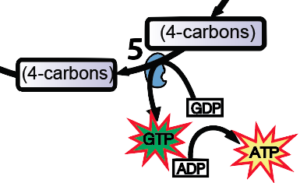 Note that in a more complex presentation of the cycle, (a tiny piece of which is shown to the left) you’d see that at step 5, a molecule called GTP (a compound closely related in structure and function to ATP) gets created before ATP itself appears. It’s a complication that you don’t need to worry about, but you’ll see it in every textbook, website, and diagram. Just know that Krebs directly creates one ATP for every two-carbon acetyl group entering the cycle.
Note that in a more complex presentation of the cycle, (a tiny piece of which is shown to the left) you’d see that at step 5, a molecule called GTP (a compound closely related in structure and function to ATP) gets created before ATP itself appears. It’s a complication that you don’t need to worry about, but you’ll see it in every textbook, website, and diagram. Just know that Krebs directly creates one ATP for every two-carbon acetyl group entering the cycle.
3b. Krebs: Six things to memorize
- Chemical energy enters the Krebs Cycle in the form of acetyl Co-A, which brings two carbons into the system.
- This two-carbon molecule combines with four-carbon oxalic acid, generating the six-carbon molecule citric acid.
- During the cycle, the cell harvests
- 1 ATP
- 3 NADHs
- 1 FADH2.
- Two molecules of CO2 are released as a waste product. This accounts for 2/3 of the CO2 produced during cellular respiration (the other third, you’ll remember, was produced in the link reaction).
- For every glucose that enters cellular respiration, the Krebs cycle runs twice (because glucose gets broken down to two pyruvates, which become two Acetyl CoA).
- This is all occurring in the mitochondrial matrix.
Got it? Let’s work with these diagrams and some of the key facts to make sure that they become consolidated in memory.
[qwiz qrecord_id=”sciencemusicvideosMeister1961-Krebs Quiz 1 (2.0)”]
[h]The Krebs Cycle Quiz 1
[i]
[q]For every two carbons that acetyl-CoA brings into the cycle, how many FADH2s will the Krebs cycle produce?
[textentry single_char=”true”]
[c]MQ ==[Qq]
[f]IFllcy4gRm9yIGV2ZXJ5IHR3byBjYXJib25zIHRoYXQgYWNldHlsLUNvQSBicmluZ3MgaW50b8KgdGhlIGN5Y2xlLMKgdGhlIEtyZWJzIGN5Y2xlIHdpbGwgcHJvZHVjZSBvbmUgRkFESA==Mg==[Qq]
[c]Kg==[Qq]
[f]Tm8uwqBTdHVkeSB0aGUgZGlhZ3JhbSBiZWxvdywgYW5kIHJlbWVtYmVyIHRoZSBhbnN3ZXIgd2hlbiB5b3Ugc2VlIHRoaXMgcXVlc3Rpb24gYWdhaW4u
Cg==Cg==[Qq]
[q]For every two carbons that acetyl-CoA brings into the cycle, how many NADHs will the Krebs cycle produce?
[textentry single_char=”true”]
[c]Mw ==[Qq]
[f]IFllcy4gRm9yIGV2ZXJ5IHR3byBjYXJib25zIHRoYXQgYWNldHlsLUNvQSBicmluZ3MgaW50b8KgdGhlIGN5Y2xlLMKgdGhlIEtyZWJzIGN5Y2xlIHdpbGwgcHJvZHVjZSB0aHJlZcKgTkFESA==cy4=[Qq]
[c]Kg==[Qq]
[f]Tm8uwqBTdHVkeSB0aGUgZGlhZ3JhbSBiZWxvdywgYW5kIHJlbWVtYmVyIHRoZSBhbnN3ZXIgd2hlbiB5b3Ugc2VlIHRoaXMgcXVlc3Rpb24gYWdhaW4u
Cg==Cg==[Qq]
[q]For every two carbons that acetyl-CoA brings into the cycle, how many ATPs will the Krebs cycle produce?
[textentry single_char=”true”]
[c]MQ ==[Qq]
[f]IFllcy4gRm9yIGV2ZXJ5IHR3byBjYXJib25zIHRoYXQgYWNldHlsLUNvQSBicmluZ3MgaW50b8KgdGhlIGN5Y2xlLMKgdGhlIEtyZWJzIGN5Y2xlIHdpbGwgcHJvZHVjZSBvbmUgQVRQLg==[Qq]
[c]Kg==[Qq]
[f]Tm8uwqBTdHVkeSB0aGUgZGlhZ3JhbSBiZWxvdywgYW5kIHJlbWVtYmVyIHRoZSBhbnN3ZXIgd2hlbiB5b3Ugc2VlIHRoaXMgcXVlc3Rpb24gYWdhaW4u
Cg==Cg==[Qq]
[q]When acetyl-CoA brings chemical energy into the TCA cycle, how many carbon atoms are being brought in?
[textentry single_char=”true”]
[c]Mg ==[Qq]
[f]IFllcy4gQWNldHlsIENvQSwgYXMgaXQgc2h1dHRsZXMgbWF0ZXJpYWwgaW50byB0aGXCoFRDQSBjeWNsZSwgaXMgYnJpbmdpbmcgaW4gMsKgY2FyYm9uIGF0b21zLg==[Qq]
[c]Kg==[Qq]
[f]Tm8uwqBTdHVkeSB0aGUgZGlhZ3JhbSBiZWxvdywgYW5kIHJlbWVtYmVyIHRoZSBhbnN3ZXIgd2hlbiB5b3Ugc2VlIHRoaXMgcXVlc3Rpb24gYWdhaW4u
Cg==Cg==[Qq]
[q]Oxaloacetate (or oxalic acid) is the molecule that accepts the carbons that Acetyl CoA brings into the Krebs cycle. How many carbons are in oxaloacetate?
[textentry single_char=”true”]
[c]NA ==[Qq]
[f]IFllcy4gT3hhbG9hY2V0YXRlIGlzIGEgZm91ci1jYXJib24=IG1vbGVjdWxlLiBCeSBjb21iaW5pbmcgd2l0aCB0d28gY2FyYm9ucyBmcm9tIEFjZXR5bCBDb0EsIGl0IGNyZWF0ZXMgdGhlIHNpeC1jYXJib24gY29tcG91bmQgQ2l0cmljIEFjaWQu[Qq]
[c]Kg==[Qq]
[f]Tm8uwqBTdHVkeSB0aGUgZGlhZ3JhbSBiZWxvdywgYW5kIHJlbWVtYmVyIHRoZSBhbnN3ZXIgd2hlbiB5b3Ugc2VlIHRoaXMgcXVlc3Rpb24gYWdhaW4u
Cg==Cg==[Qq]
[q]Citrate (or citric acid) results from the combination of oxaloacetate and the two carbons brought to the Citric Acid cycle by Acetyl CoA. How many carbons are in citrate (or citric acid)?
[textentry single_char=”true”]
[c]Ng ==[Qq]
[f]IFllcy4gQ2l0cmljIGFjaWQgaXMgYSA2LWNhcmJvbiBtb2xlY3VsZSwgZm9ybWVkIGFzIGVuenltZXMgY29tYmluZSB0aGUgdHdvIGNhcmJvbnMgZnJvbSBBY2V0eWwgQ29BIHdpdGggdGhlIGZvdXItY2FyYm9uIG94YWxvYWNldGF0ZS4=[Qq]
[c]Kg==[Qq]
[f]Tm8uwqBTdHVkeSB0aGUgZGlhZ3JhbSBiZWxvdywgYW5kIHJlbWVtYmVyIHRoZSBhbnN3ZXIgd2hlbiB5b3Ugc2VlIHRoaXMgcXVlc3Rpb24gYWdhaW4u
Cg==Cg==[Qq]
[q]In reaction 3 in the diagram below, NAD+ is being
[c]b3hpZGl6ZWQ=[Qq]
[c]cmVkdW NlZA==[Qq]
[c]cGhvc3Bob3J5bGF0ZWQ=[Qq]
[f]Tm8uIE5BRA==Kw==IGlzIGdhaW5pbmcgZWxlY3Ryb25zLiBUaGUgZ2FpbiBvZiBlbGVjdHJvbnMgaXMgdGhlIA==b3Bwb3NpdGU=IG9mIG94aWRhdGlvbi4=[Qq]
[f]WWVzISBOQUQ=Kw==IGlzIGdhaW5pbmcgZWxlY3Ryb25zwqBhbmQgYmVpbmcgcmVkdWNlZCB0byBOQURILg==[Qq]
[f]Tm8uwqBQaG9zcGhvcnlsYXRpb24gaGFwcGVucyBpbiB0aGUgS3JlYnMgY3ljbGUsIGJ1dCBub3QgaGVyZSBpbiByZWFjdGlvbiAzLiBXaGF0JiM4MjE3O3MgdGhlIG5hbWUgZm9yIHRoZSBwcm9jZXNzIHdoZW4gYSBzdWJzdGFuY2UgZ2FpbnMgZWxlY3Ryb25zIChhcyB3ZWxsIGFzIGh5ZHJvZ2VuKT8=
Cg==Cg==[Qq]
[q]Reaction 5 in the diagram below involves a(n)
[c]b3hpZGF0aW9u[Qq]
[c]cmVkdWN0aW9u[Qq]
[c]cGhvc3Bob3 J5bGF0aW9u[Qq]
[f]Tm8uIE94aWRhdGlvbiBpbnZvbHZlcyB0aGUgbG9zcyBvZiBlbGVjdHJvbnMuIEluIHRoZSBLcmVicyBjeWNsZSwgbW9sZWN1bGVzIGZyb20gZm9vZCBhcmUgb3hpZGl6ZWQgc28gdGhhdCB0aGUgZWxlY3Ryb24gY2FycmllcnMgTkFEKyA=YW5kIEZBRMKgY2FuIMKgYmUgcmVkdWNlZCB0byBOQURIIGFuZCBGQURIMg==[Qq]
[f]Tm8uIFJlZHVjdGlvbiBpbnZvbHZlcyB0aGUgZ2FpbiBvZiBlbGVjdHJvbnMgKGFuZCBoeWRyb2dlbikuIEluIHRoZSBLcmVicyBjeWNsZSwgdGhlcmUgYXJlIHN0ZXBzIHdoZXJlIE5BRA==KyA=YW5kIEZBRCBhcmUgcmVkdWNlZCB0byBOQURIIGFuZCBGQURIMg==wqAoYnV0IHRoYXQmIzgyMTc7cyBub3QgaGFwcGVuaW5nIGhlcmUgaW4gc3RlcCA1KS4gV2hhdCYjODIxNztzIGl0IGNhbGxlZCB3aGVuIEFEUCBhbmQgUA==[Qq]i are made into ATP through the action of enzymes?
[f]WWVzLiBUaGUgcmVhY3Rpb24gc2hvd24gaW4gc3RlcCA1IGlzIGEgc3Vic3RyYXRlLWxldmVsIHBob3NwaG9yeWxhdGlvbiwgY29udmVydGluZyBBRFAgdG8gQVRQLg==
Cg==[Qq]
[q]In reaction 6 in the diagram below, FAD is being
[c]cGhvc3Bob3J5bGF0ZWQ=[Qq]
[c]b3hpZGl6ZWQ=[Qq]
[c]cmVkdW NlZA==[Qq]
[f]Tm8uIFN1YnN0cmF0ZSBsZXZlbCBwaG9zcGhvcnlsYXRpb24gaW52b2x2ZXMgZW56eW1lcyBhZGRpbmcgcGhvc3BoYXRlIHRvIEFEUCwgY3JlYXRpbmcgQVRQLiBIZXJlLCBpbiBzdGVwIDYsIEZBRMKgaXMgZ2FpbmluZyBlbGVjdHJvbnMgKGFuZCBoeWRyb2dlbnMpLiBXaGF0JiM4MjE3O3MgdGhlIG5hbWUgZm9yIHRoZSBnYWluIG9mIGVsZWN0cm9ucz8=[Qq]
[f]Tm8uwqBPeGlkYXRpb24gaXMgdGhlIGxvc3Mgb2YgZWxlY3Ryb25zLiBTb21ldGhpbmcgaXMgYmVpbmcgb3hpZGl6ZWQgaGVyZSwgYnV0IGl0JiM4MjE3O3Mgbm90IEZBRCwgd2hpY2ggaXMgZXhwZXJpZW5jaW5nIHRoZSA=b3Bwb3NpdGU=IG9mIG94aWRhdGlvbi4gV2hhdCYjODIxNztzIGl0IGNhbGxlZCB3aGVuIGEgc3Vic3RhbmNlIGdhaW5zIGVsZWN0cm9ucyAoYW5kIGh5ZHJvZ2VuKT8=[Qq]
[f]WWVzLiBJbiBzdGVwIDYswqBGQUTCoGlzIGdhaW5pbmcgZWxlY3Ryb25zIChhbmQgaHlkcm9nZW5zKSwgYmVjb21pbmcgcmVkdWNlZCB0byBGQURIMg==Lg==
Cg==[Qq]
[q]In reaction 8, molecules originally from food are being
[c]cGhvc3Bob3J5bGF0ZWQ=[Qq]
[c]b3hpZG l6ZWQ=[Qq]
[c]cmVkdWNlZA==[Qq]
[f]Tm8uIFBob3NwaG9yeWxhdGlvbiBpbnZvbHZlcyBhZGRpbmcgYSBwaG9zcGhhdGUgZ3JvdXAgdG8gYSBzdWJzdGFuY2UuIEluIHRoZSBLcmVicyBjeWNsZSwgb25lIHBob3NwaG9yeWxhdGlvbiBvY2N1cnMgd2hlbiBBRFAgaXMgbWFkZSBpbnRvIEFUUCwgYnV0IHRoYXQmIzgyMTc7cyBub3Qgd2hhdCYjODIxNztzIGhhcHBlbmluZyBoZXJlLiBXaGF0IGhhcyB0byBoYXBwZW4gdG8gZm9vZCBzbyB0aGF0IE5BRA==Kw==IGNhbiBiZSByZWR1Y2VkIHRvIE5BREg/[Qq]
[f]WWVzLiBGb3IgTkFEKw==wqB0byBiZSByZWR1Y2VkIHRvIE5BREgsIGZvb2QgaGFzIHRvIGJlIG94aWRpemVkICh3aGljaCBwcm92aWRlcyB0aGUgZWxlY3Ryb25zIGFuZCBoeWRyb2dlbnMgZm9yIE5BRA==Kw==IHJlZHVjdGlvbiku[Qq]
[f]Tm8uIEluIHN0ZXAgOCwgTkFEKw==IGlzIHJlZHVjZWQgdG8gTkFESC4gRm9yIHRoaXMgcmVkdWN0aW9uIHRvIGhhcHBlbiwgd2hhdCBoYXMgdG8gYmUgaGFwcGVuaW5nIHRvIGZvb2QgKHRvIHByb3ZpZGUgdGhlIGVsZWN0cm9ucyBhbmQgaHlkcm9nZW5zIGZvciB0aGlzIHJlZHVjdGlvbik/
Cg==[Qq]
[q]In the diagram below, which number shows where the Krebs Cycle occurs?
[textentry single_char=”true”]
[c]NQ ==[Qq]
[f]IFllcy4gVGhlIEtyZWJzIGN5Y2xlIG9jY3VycyBpbiB0aGUgbWl0b2Nob25kcmlhbCBtYXRyaXgsIHdoaWNoIGlzIGF0IG51bWJlciA1Lg==[Qq]
[c]Kg==[Qq]
[f]Tm8uIEhlcmUmIzgyMTc7cyBhIGhpbnQuwqBUaGUgS3JlYnMgY3ljbGUgb2NjdXJzIHdpdGhpbiB0aGUgbWl0b2Nob25kcmlhbCBtYXRyaXguIFdoYXQgbnVtYmVyIGNvdWxkIHRoYXQgYmU/
Cg==[Qq]
[q]Before the link reaction, you’d find pyruvate in which part of the cell?
[textentry single_char=”true”]
[c]Mw ==[Qq]
[f]IFllcy4gUHlydXZhdGUgaXMgbWFkZSBkdXJpbmcgZ2x5Y29seXNpcywgd2hpY2ggb2NjdXJzIGluIHRoZSBjeXRvcGxhc20gb2YgdGhlIGNlbGwsIGFzIHNob3duIGluIG51bWJlciAzLg==[Qq]
[c]Kg==[Qq]
[f]Tm8uIEhlcmUmIzgyMTc7cyBhIGhpbnQuwqBQeXJ1dmF0ZSBpcyBnZW5lcmF0ZWQgZHVyaW5nIHRoZSBsYXN0IHBoYXNlIG9mIGdseWNvbHlzaXMsIHdoaWNoIG9jY3VycyBpbiB0aGUgY2VsbCYjODIxNztzIGN5dG9wbGFzbS4gV2hpY2ggbnVtYmVyIGNvdWxkIGJlIHRoZSBjeXRvcGxhc20/
Cg==[Qq]
[q]In the diagram below, which numbered step shows the link reaction?
[textentry single_char=”true”]
[c]Mg ==[Qq]
[f]IFllcy4gVGhlIExpbmsgUmVhY3Rpb24gaXMgb2NjdXJyaW5nIGluIHN0ZXAgMiwgYXMgcHlydXZhdGUgZW50ZXJzIHRoZSBtaXRvY2hvbmRyaWEsIGdldHMgY29udmVydGVkIHRvIEFjZXR5bCBDb0EsIHJlbGVhc2VzIENPMiw=IGFuZCBnZW5lcmF0ZXMgb25lIE5BREgu[Qq]
[c]Kg==[Qq]
[f]Tm8uIEhlcmUmIzgyMTc7cyBhIGhpbnQuwqBUaGXCoGxpbmsgcmVhY3Rpb24gbGlua3MgZ2x5Y29seXNpcyBhbmQgdGhlIEtyZWJzIGN5Y2xlLiBXaGljaCBzdGVwIHByb3ZpZGVzIGEgbGluayBiZXR3ZWVuIHRob3NlIHR3b8KgcHJvY2Vzc2VzPw==
Cg==[Qq]
[q]In the diagram below, which number would be the Krebs cycle?
[textentry single_char=”true”]
[c]Mw ==[Qq]
[f]IFllcy4gVGhlIEtyZWJzIGN5Y2xlwqBpcyBhdCBudW1iZXIgMy4=[Qq]
[c]Kg==[Qq]
[f]Tm8uIEhlcmUmIzgyMTc7cyBhIGhpbnQuIFdoaWNoIG9mIHRoZSBwcm9jZXNzZXMgc2hvd24gaW4gdGhpcyBkaWFncmFtIGNvdWxkIGJlIGEgY3ljbGU/
Cg==[Qq]
[q]For each molecule of glucose that enters cellular respiration, which of the processes below generates the most NADH?
[c]Z2x5Y29seXNpcw==[Qq]
[c]bGluayByZWFjdGlvbg==[Qq]
[c]S3JlYnMg Y3ljbGU=[Qq]
[c]ZWxlY3Ryb24gdHJhbnNwb3J0IGNoYWlu[Qq]
[f]Tm8uwqBHbHljb2x5c2lzIGdlbmVyYXRlcyBvbmx5IHR3byBOQURIcy9nbHVjb3NlLiBTdHVkeSB0aGUgZGlhZ3JhbSBiZWxvdyBhbmQgcmVtZW1iZXIgeW91ciBhbnN3ZXIgdGhlIG5leHQgdGltZSB5b3Ugc2VlIHRoaXMgcXVlc3Rpb24u
Cg==[Qq]
[f]Tm8uIFRoZSBsaW5rIHJlYWN0aW9uIGdlbmVyYXRlcyBvbmUgTkFESC9weXJ1dmF0ZSBhbmQgdHdvIE5BREhzL2dsdWNvc2UuIFN0dWR5IHRoZSBkaWFncmFtIGJlbG93IGFuZCByZW1lbWJlciB5b3VyIGFuc3dlciB0aGUgbmV4dCB0aW1lIHlvdSBzZWUgdGhpcyBxdWVzdGlvbi4=
Cg==[Qq]
[f]WWVzLsKgVGhlwqBLcmVicyBjeWNsZcKgZ2VuZXJhdGVzIG1vcmUgTkFESC9nbHVjb3NlIHRoYW4gYW55IG90aGVyIHBoYXNlIG9mIGNlbGx1bGFyIHJlc3BpcmF0aW9uLg==
Cg==[Qq]
[f]Tm8uIFRoZSBlbGVjdHJvbiB0cmFuc3BvcnQgY2hhaW4gZG9lc24mIzgyMTc7dCBwcm9kdWNlIE5BREg6IGl0IGNvbnN1bWVzIGl0LiBTdHVkeSB0aGUgZGlhZ3JhbSBiZWxvdyBhbmQgcmVtZW1iZXIgeW91ciBhbnN3ZXIgdGhlIG5leHQgdGltZSB5b3Ugc2VlIHRoaXMgcXVlc3Rpb24u
Cg==[Qq]
[x][restart]
[/qwiz]
4. Interactive Diagram: Products of the Krebs Cycle
The diagram below is a bit more detailed than anything you’ve seen before on this page. But you can figure it out by following these hints:
- If a molecule within the cycle is losing hydrogen, then it’s being oxidized, and it can power the reduction of NAD+ to NADH.
- If a molecule loses a carboxyl group, then it’s almost certainly releasing CO2.
- At one point in the cycle, one of the substrates loses two hydrogens. That loss enables the reduction of FAD to FADH2.
- ATP is made from ADP in two steps. First, a related molecule (GTP) is synthesized from its counterpart, GDP. Then GTP powers ATP creation. See if you can figure it out.
DON’T WORRY ABOUT MAKING MISTAKES!
[qwiz qrecord_id=”sciencemusicvideosMeister1961-Products of the Krebs Cycle Diagram (2.0)”]
[h]Products of the Krebs Cycle interactive diagram
[q labels = “top”]
[l]NAD+
[fx] No, that’s not correct. Please try again.
[f*] Correct!
[l]NADH
[fx] No, that’s not correct. Please try again.
[f*] Correct!
[l]CO2
[fx] No. Please try again.
[f*] Great!
[l]FADH2
[fx] No. Please try again.
[f*] Good!
[l]GDP
[fx] No, that’s not correct. Please try again.
[f*] Correct!
[l]GTP
[fx] No, that’s not correct. Please try again.
[f*] Correct!
[l]ADP
[fx] No, that’s not correct. Please try again.
[f*] Great!
[l]ATP
[fx] No, that’s not correct. Please try again.
[f*] Good!
[l]FAD
[fx] No. Please try again.
[f*] Great!
[/qwiz]
5. Krebs Cycle Music Video
This video will help your review everything you’ve learned above. Enjoy!
6. Krebs and Link Reaction Fill in the Blanks Quiz
[qwiz qrecord_id=”sciencemusicvideosMeister1961-Krebs and Link Reaction Quiz (2.0)”]
[h]Krebs Cycle and Link Reaction Fill-in-the-Blanks Quiz
[i]
[q] The Krebs cycle occurs in the [hangman] of the mitochondria. The cycle makes the [hangman] carriers NADH and FADH2.
[c]bWF0cml4[Qq]
[c]ZWxlY3Ryb24=[Qq]
[q]The Krebs cycle makes the electron carriers [hangman] and FADH2
[c]TkFESA==[Qq]
[q]Krebs is also known as the [hangman] acid cycle and the tri[hangman]acid.
[c]Q2l0cmlj[Qq]
[c]Y2FyYm94eWxpYw==[Qq]
[q]Each turn of the Krebs cycle produces one ATP, [hangman] NADH, and [hangman] FADH2.
[c]dGhyZWU=[Qq]
[c]b25l[Qq]
[q]The link reaction converts [hangman] acid to Acetyl-CoA. Carbon dioxide is released as a [hangman] product, and one [hangman] is produced.
[c]cHlydXZpYw==[Qq]
[c]d2FzdGU=[Qq]
[c]TkFESA==[Qq]
[q]Acetyl-CoA carries [hangman] carbon atoms into the Krebs cycle. The chemical energy brought into Krebs by acetyl Co-A was originally energy in [hangman],
[c]dHdv[Qq]
[c]Zm9vZA==[Qq]
[q]At the start of Krebs Acetyl-CoA’s two carbons combine with oxaloacetate, a [hangman] carbon molecule
[c]Zm91cg==[Qq]
[q]During the Krebs cycle, three oxidations power the creation of the electron carrier [hangman]. The final oxidation reaction in Krebs results in [hangman] of FAD to FADH2 and leaves us with the [hangman]-carbon molecule oxaloacetate.
[c]TkFESA==[Qq]
[c]cmVkdWN0aW9u[Qq]
[c]Zm91cg==[Qq]
[q]The link reaction links [hangman] to the Krebs Cycle. It converts pyruvic acid to Acetyl-CoA. Carbon dioxide is released as a waste product, and one [hangman] is produced.
[c]Z2x5Y29seXNpcw==[Qq]
[c]TkFESA==[Qq]
[q]Combining Acetyl-CoA with oxaloacetate creates six-carbon [hangman] acid.
[c]Y2l0cmlj[Qq]
[q]During Krebs [hangman] molecules of carbon dioxide are released as exhaust.
[c]dHdv[Qq]
[x][restart]
[/qwiz]
7. Krebs Cycle Karaoke
The ultimate Krebs cycle challenge.
What’s next?
-
- Proceed to Topic 3.5, Part 4: The Electron Transport Chain and Chemiosmosis (the next tutorial in AP Bio Unit 3)
